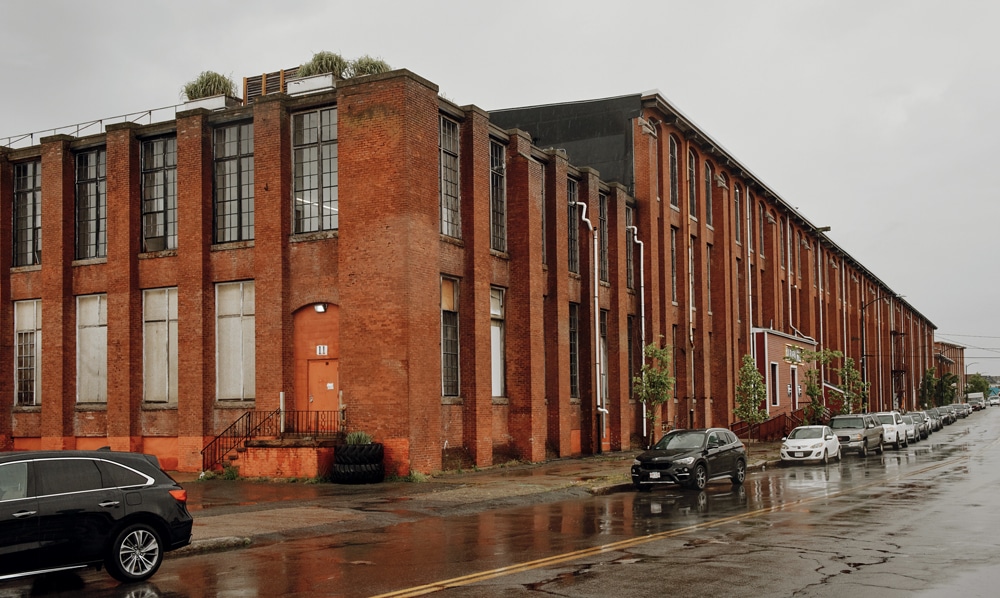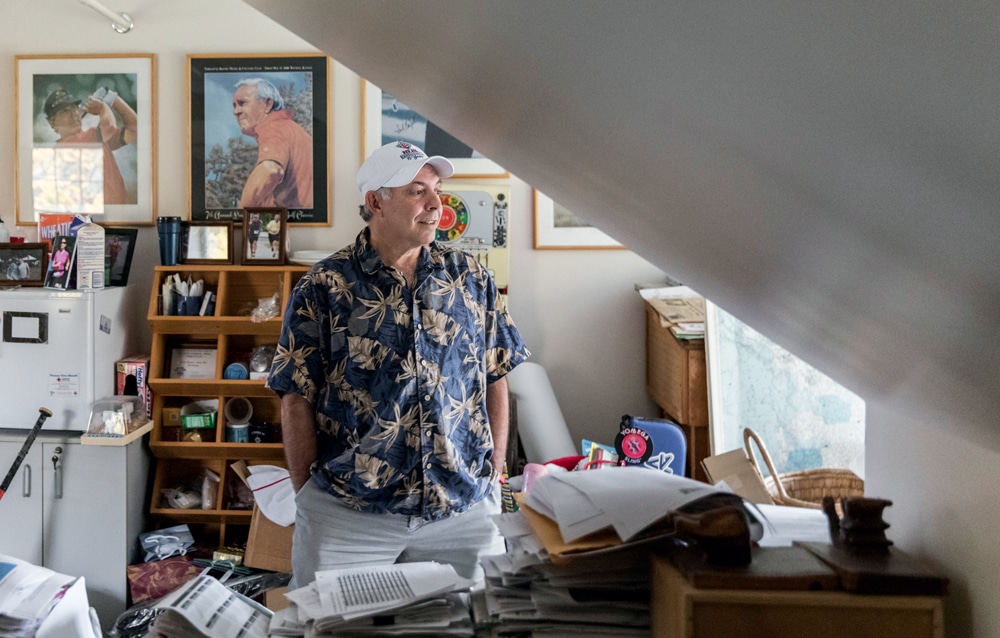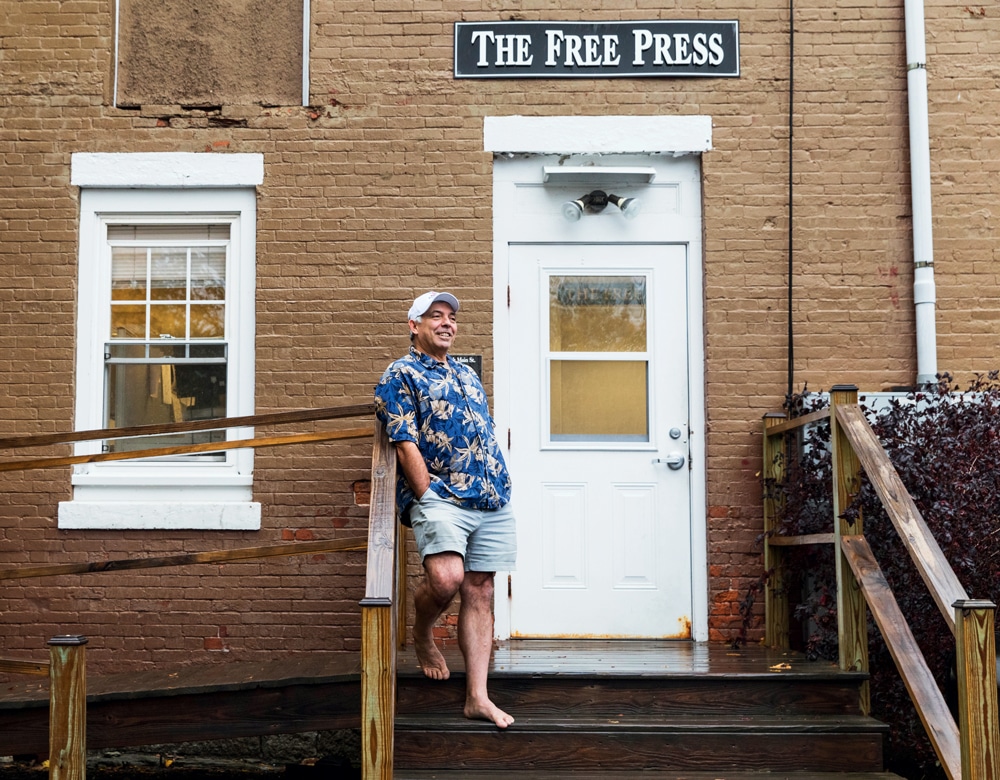Hard-Pressed | The Fight to Save the Small-Town Newspaper
With New England’s long tradition of small-town newspapers under threat, communities and journalists are fighting to stick together and stay informed.

Coffee By Design | Portland, Maine
Photo Credit : Katherine Keenan
Photo Credit : Anna watts
A trim 85, in his trademark blue blazer, tasseled loafers, and wire-rim glasses, Phil Camp strolls across Elm Street to the general store in downtown Woodstock, Vermont, to replenish the supply of coffee for his office, returning the smiles and waves of everyone he passes.
“He’s like the mayor of Woodstock,” a colleague says with a laugh.
The store was founded in 1886, making it an upstart compared to the weekly newspaper Camp owns, the Vermont Standard, which since 1853 has chronicled local triumphs and tragedies, births and deaths, Little League scores and garden club meetings, high school graduations, business openings, and petty crimes.
The Standard occupies the building it once shared with Camp’s grandfather’s funeral home. Back then, the presses had to be shut down when there was a funeral because the floor would shake so much. “It really was that homespun,” he remembers.

Photo Credit : Anna Watts
Still is. There’s the smell of ink and newsprint from the bundles of back issues on the floor, and a handwritten list of next week’s advertisers thumbtacked to a bulletin board.
The newspaper moved back here after surviving a flood in 2011 in one rented office when the Ottauquechee River overflowed, then a fire in another in 2018. Now it’s trying to surmount another threat: the destructive changes to an industry threatened by shifting reader habits, shrinking advertising, and acquisitions by distant corporations that starve newspapers of their resources and strip them of their assets.
Those challenges are as urgent in New England as anywhere else. But something else is happening here. New Englanders still disproportionally support their local newspapers, far fewer of which have closed than in the rest of the country. Circulation rose during the Covid-19 pandemic, when readers were reminded of the value of local news; many even sent in unsolicited donations. There are fewer “news deserts”—places with no local media outlets at all. Nonprofits and student journalists are stepping in to fill what gaps exist. And wealthy residents in places from Nantucket to the Berkshires to Harpswell, Maine, are taking over or buying back their community newspapers, or starting new ones.
Camp was among the first. After leaving to make his fortune in the ski industry, he came home and bought the local paper he had once delivered from a wagon as a kid. He still subsidizes it to the tune of about $3,000 every time it prints its weekly edition, according to his publisher, Dan Cotter. “It’s a hell of a way to make any money. I learned that the hard way,” Camp says.
But there’s a broader debt he says he’s trying to repay.
The local newspaper is the glue that pulls together towns like his, keeps their residents connected, supports their businesses, and holds their powerful accountable. “I was born and raised here,” he says. “This town made me what I am. I got a lot of breaks. They passed the hat at Rotary to raise my university tuition. This is a very small way of saying thanks.”
Camp lets out a rare burst of anger when asked what would happen if he and people like him didn’t keep alive the tradition of the local newspaper.
“Some vultures would come in and find a way to put out a rag,” he says contemptuously.
The vultures Camp is talking about, along with other economic, social, and technological realities, have already cost the nation one-quarter of its newspapers, including more than 2,000 weeklies, since 2004. About 90 shut down during the pandemic. Of those that remain, many have been scooped up and pared down by national chains and hedge funds with few ties to the communities they cover, such as Gannett, which owns 613 papers; Digital First/Tribune (207); and Lee/BH Media (170).
New England hasn’t been entirely spared from this dramatic downturn. Massachusetts and Connecticut have been favorite hunting grounds for the big chains, which have bought up (and in some cases shut down) large numbers of newspapers there and left many others ghosts of what they once were. Fifty-five weeklies in Connecticut and 67 in Massachusetts closed between 2004 and 2019, and another seven—six of them owned by Gannett—during the pandemic. Others have reduced the number of days they publish, laid off staff, outsourced content, or gone partly or fully digital.
Elsewhere in the region, though, the losses have been much, much smaller. Of the thousands of newspapers closed nationwide since 2004, 12 were in Maine, three in Vermont, two in New Hampshire, and one in Rhode Island. Only four daily newspapers out of 81 in New England shut down in that period. And while the South has 91 counties with no media outlet at all, New England has but one. That’s by far the smallest number of any region in the country.
Those familiar plastic tubes still stand next to a vast number of mailboxes along New England country roads awaiting delivery of the local paper. Journalists still labor on, in offices that look like Norman Rockwell prints in towns that could be settings for Frank Capra films. Half of their readers say the local news they get is still relevant and useful—two and a half times the proportion of their fellow Americans who think so. “You may be a son of a gun, in their opinion, but you’re their son of a gun,” says Earl Brechlin, retired editor of the Bar Harbor Times in Maine. “People here see newspapers as part of the fabric of their communities,” he adds. “A lot of the newspapers in New England are older than many towns in other parts of the United States.”
It was in Cambridge, Massachusetts, in 1638, that the first printer in Britain’s American colonies set up shop. The first newspaper was in Boston. With the advancement of the steam-powered printing press in the 1820s, newspapers got so cheap that even the lowest-paid workers in New England’s fast-growing industrial cities could afford to buy one. Scores of them did; Massachusetts and Connecticut as early as the mid-17th century required that everyone be taught to read, and literacy was widespread. There were huge numbers of newspapers, with massive circulations. At one point, Boston had nine dailies; just one of them, the Boston Post, had 628,000 subscribers.
“For 250 years this culture on the East Coast has been super-steeped in reading,” says Heidi Legg, a research fellow at the Future of Media Project at Harvard’s Kennedy School. “It’s a culture that craves and elevates this sense of being literate and being informed.”

Photo Credit : Susan Lapide
Civic life is also more hands-on here. The tradition of town meeting in particular brings together everyone in a community. “There’s a level of civic engagement you don’t have in a lot of other places. You’re going to get up and argue about $10 a year for extra chalk,” says Brechlin.
Local newspapers are essential to this system, says Penelope Muse Abernathy, a scholar of news deserts and ghost newspapers and a professor at Northwestern University’s Medill School of Journalism, who rode out much of the pandemic in Vermont. “You rely on that newspaper to let you know what’s going on.”
Such essential chroniclers of local history are they that when the Clinton Item in Massachusetts closed its office, 50 volunteers stepped up in March to move the 400 bound green volumes of back issues in a human chain to the town’s history museum.
Brechlin remembers one group of coastal Maine towns losing their newspaper after it was bought by new owners, before someone else stepped in to revive it. “Those towns didn’t have a paper for a couple of weeks,” he says. “And I think people realized, Oh, crap, this is important to us.”
So what happens when the newspapers disappear for good?
When a hurricane in August took aim at the densely populated coastal city of New Bedford, Massachusetts, whose fishing fleet is the largest in America, Mayor Jon Mitchell called a news conference to detail the precautions that were planned. When he looked out from the podium on that anxious Saturday morning, Mitchell saw a handful of mostly out-of-town reporters. But he was struck by who was absent. The local newspaper, the Standard-Times, had no one in attendance.
“Our newspaper was not there,” says Mitchell. “They just didn’t show up. Impending natural disaster, the mayor calls a press conference, and they weren’t there.”
He sounds incredulous, but the mayor wasn’t really that surprised. The newspaper, which dates back in one form or another to 1850, had been hemorrhaging reporters as it bounced from one national owner to another; the newsroom directory lists five reporters and editors and a photographer, down from 50. Now the property of Virginia-based Gannett, the Standard-Times produces rewritten news releases and covers high school sports, its critics say, but offers almost none of the kind of watchdog journalism that communities need from their newspapers.
Even politicians, often targets of that scrutiny, are alarmed about this trend. “Local newspapers play an indispensable role in not only holding public officials accountable—and maybe that’s why so few have spoken up about the problem—but more fundamentally they establish a bulwark of trust in a community,” says Mitchell, a former federal prosecutor.
So important does he consider this that Mitchell made it part of his annual state-of-the-city address, asking people to support the Standard-Times: “Your city needs it to function effectively.” When things still didn’t improve, he encouraged a group of local investors to buy the paper, but Gannett wouldn’t sell. “We’re in a situation now where much of the narrative of Greater New Bedford isn’t being told by anybody,” Mitchell says. “That leaves the door open for less government accountability. It may not be in my enlightened political self-interest, but it’s something that my city needs.”
The importance of community journalism is about more than nostalgia and sentiment. In places where local newspaper circulation falls, one study found, so does voter turnout. In cities and towns where newspapers close or have been hollowed out, government efficiency declines, taxes rise, and municipal borrowing costs increase, another study showed. Yet other research suggests that, by focusing on local issues that cross party lines, local newspapers blunt the spread of political polarization. What happens in a small city or town, after all, often has more immediate impact on people’s lives than what happens in Washington.
John Barrett remembers parrying with reporters from three different papers during the 26 years that he was mayor of North Adams, Massachusetts. “They were there every day,” says Barrett, now a state representative. “They were watching government very closely, and you know what? It made me a better public official and it kept me on my toes.” Then a series of owners bought the daily North Adams Transcript, which ended up disappearing as an independent newspaper and being merged into the Berkshire Eagle.
“Now it’s not unusual that school committee meetings aren’t covered, planning boards aren’t covered, and so much is being lost. And the people paying the price are the ones that are living in the communities, who relied upon the newspaper,” Barrett says. “I had my battles with editors. I can get in arguments with reporters as well as anybody. But I miss that. All I hear today in politics is, ‘We need transparency.’ Well, we have transparency when we have newspapers.”
With the weekly edition of the Addison County Independent written and laid out—“put to bed,” in journalism parlance—and on its way to front stoops all over town, Angelo Lynn takes a breath in the corner office of the onetime toothbrush bristle factory on the far edge of downtown Middlebury, Vermont, that houses the newspaper and several others Lynn and his family run.
He writes the editorials and some of the stories, edits The Reporter, and sells ads. His wife, Lisa Gosselin, a former state commerce commissioner and magazine industry veteran who previously worked at Audubon, Islands, Bicycling, Eating-Well, and Skiing, is the editor and publisher of Vermont Sports and VT Ski+Ride, two regional magazines that help keep the company afloat.
One of their three daughters, Polly Lynn Mikula, is co-publisher and editor of the Mountain Times in Killington; her sisters, Christy Lynn and Elsie Lynn, are advertising manager for the Independent and the Reporter and graphics designer, arts and leisure reporter, human resources manager, bookkeeper, and IT guru, respectively. Mikula’s husband, Jason, is the advertising manager at the Mountain Times.
In a conference room on whose shelves are strewn antique cameras and bound back issues, they laugh at the inevitable question—why these 30-somethings and their parents choose to continue running local newspapers, of all businesses, and now of all times. “We ask ourselves that a lot,” says Christy Lynn.
It hasn’t been easy. Advertising revenue was down during the pandemic, and the Independent cut back on its print edition from twice to once a week. Not only is it tough to attract young readers; young media buyers won’t take space in the print edition unless they can measure exactly how many people read the ads, the same way they can count the clicks online. “It’s really a funny mind-set and a frustrating one,” Angelo Lynn says. He believes the best place to reach a whole town is in the pages of its local paper. “But suddenly people don’t believe that’s true.”
It’s not lost on newspaper editors and publishers in New England that one reason they’ve endured is because the aging population—first, second, and third oldest in the country in Maine, New Hampshire, and Vermont—has long relied on newspapers. (“Read the obits. Every day I lose subscribers,” says Fredric Rutberg, publisher of the Berkshire Eagle.)
The Lynn sisters say that younger readers are there for the taking. “You don’t care about school coverage till you have kids. Then you want to read the paper,” Christy Lynn says. She covers the mountain biking club and sees her online traffic go up. “So we know they’re reading.” More people are checking out the website these days, and the papers now post video clips on Instagram and have started a newsletter for readers with young kids. Those don’t pay the bills, though. “I talk to people a lot who tell me they follow us on Facebook,” says Christy Lynn. “And I’m, like, ‘Cool, but can you send us 50 bucks and subscribe, please?’”
What readers get from their local papers reflects the day-to-day things that make New England charming, distinctive, and occasionally confounding. The biggest story in Woodstock has been about a proposal to hand over a park to the town, along with the trust established by the donor for its upkeep—but some neighbors of the park don’t like the idea and want to leave things as they are. “Welcome to Vermont,” jokes Phil Camp.
Local journalists in Easton, Connecticut, have chronicled a debate over whether the town should accept a state grant to build a bike trail and walking path, which some residents fear would attract commercial development. “It’s a fascinating cultural issue: If we build a sidewalk, a Walmart will be next,” says James Castonguay, director of the School of Communication, Media and the Arts at nearby Sacred Heart University.
The Charlotte News in Vermont ran a story about a man who caught a trout. Readers of the Penobscot Bay Pilot were treated to a feature and photos of a firefighter rescuing a cat from a tree; that story won an award from the Maine Press Association. The Addison County Independent covered a new plant converting cow manure into natural gas, new stores downtown, and the youth theater presentation of Newsies. But local papers also cover painful and contentious topics, often at the risk of blowback from their towns.
After the Berkshire Eagle covered the manslaughter conviction of a North Adams, Massachusetts, woman whose father died because she was afraid he’d be put into a nursing home if she took him to a doctor, a reader confronted the publisher, Rutberg. “Why did you have to print all this?” she asked him.
The Nantucket Inquirer and Mirror exposed how elected commissioners of a land bank funded by a fee on real estate transactions tried to use some of the money to build a clubhouse at the golf course of which they were members. It also ran a five-part series about the threat to the island from sea-level rise. “The real estate community was furious that we had written it and it was on the front page and in the [peak tourist] season,” says editor and publisher Marianne Stanton.
In Maine, the Lewiston Sun Journal reported that a former police officer who died of an opioid overdose had been stealing drugs from dealers. The Bangor Daily News chronicled the almost unchecked power of local sheriffs and found that at least five male guards in a Bangor jail had sexually harassed their female colleagues or committed other offenses, but kept their jobs, and that a local school had physically restrained its students with disabilities and put them in “seclusion rooms” at least 1,200 times in three years. “These kinds of stories aren’t being told anywhere else,” says Earl Brechlin.
They also matter as much to the journalists—who live, and are often from, these towns—as to their readers. Walking her dogs in the Rockport, Maine, dog park after wrapping up a deadline story, for example, Lynda Clancy, editor of the PenBay Pilot, greets not only the owners by name, but all of the dogs too. Local journalists and editors “are accountable from the moment you wake up until you go to sleep,” she says. “If you go to the grocery store, you’re going to be caught up in conversation, or down to the bait shop at the harbor. There’s no end.” And not only do local journalists know everybody, Brechlin adds, “you know their stories and you know their families’ stories, and you know the stories that don’t get into the newspapers as well as the ones that do. You interact with people on their best days and their worst days.”
Stories about cats in trees, meanwhile, lower the collective angst, says Elizabeth Hansen Shapiro, CEO and cofounder of the Massachusetts-based Trust for Local News. Given the state of national politics, there’s a real fatigue with national news, she says. “People are craving shared context, especially at the local level—What is this place where I live and who are these people around me? Sometimes you want to open the paper and just read about the guy who caught the trout.”
The dust has barely settled from the build-out of the squat, red brick textile mill where the New Bedford Light went live in June. Set up and run by former editors and reporters from the Standard-Times and others, the free, nonprofit news site launched in response to growing concern that the city wasn’t being adequately covered. It has already produced a months-long investigation of the effect of the pandemic, discovering that the more than 400 people in New Bedford killed by Covid include a disproportionate number of retired textile workers who had underlying respiratory conditions probably related to their work.

Photo Credit : Tony Luong
“There needs to be deeper coverage of government, deeper coverage of business—of any center of power—and broader coverage of communities themselves” than is being provided by the skeleton staffs of local newspapers with absentee owners, says Barbara Roessner, the Light’s founding editor and a Pulitzer Prize–winning former managing editor of the Hartford Courant. The publisher is Stephen Taylor, a former Boston Globe executive whose family once owned the Globe, and advisors include Walter Robinson, former head of the Globe Spotlight Team. The project raised its first $100,000 ahead of schedule from 248 contributors Roessner says are mostly local. “We don’t have to do much explaining” to solicit these donations, she says. “They’ve seen the decline in local news coverage in their city.”

winning former managing editor of the Hartford Courant, today leads the New Bedford Light, a nonprofit news site that launched last year in an old textile mill (below) in New Bedford, Massachusetts.
Photo Credit : Tony Luong
Nonprofits like the Light are stepping in to fill those gaps—the New Hampshire Bulletin, the CT Mirror, the New Haven Independent, the Maine Monitor. A dozen or more journalism nonprofits have started up each year since 2008, according to the Institute for Nonprofit News; last year alone, 20 of them did. “In this environment, everybody has to be willing to adapt,” says Anne Galloway, editor of the nonprofit VTDigger, an online news daily that she founded after she was laid off from her job as Sunday editor at the Rutland Herald and Times Argus. It has broken stories about a woman who died in a Vermont jail because she wasn’t given the right medication, and about one of the state’s largest-ever cases of fraud, which encouraged foreign nationals to invest, in exchange for green cards, in an economic development project that was never built.
In other places in New England where newspapers have closed down or faded away, journalism faculty and students are stepping in. Faculty and students at Sacred Heart University in Connecticut relaunched the Easton Courier last year as a free, nonprofit online news site after the newspaper was bought by Hearst and shut down. Students at the University of Vermont produce journalism for two dozen local papers around the state, under the supervision of professional editors. Among other things, they’ve filled the void left when the Waterbury Record folded at the onset of the Covid crisis, helping create the Waterbury Roundabout to cover news in the community.
The idea is not only to make sure that news continues to be covered, but that young journalists consider careers in local media. Several have gone on to full-time jobs at local papers, often in the communities they’re from. There were 50 last year in the program. “That’s a lot of people getting excited about what they’re doing,” says Cory Dawson, the project’s editor.

Photo Credit : Anna watts
It’s a similar route to the one that Dawson took. After getting a graduate degree in journalism, he returned to his native Burlington, where he worked at the Free Press until he got laid off. Now he runs UVM’s Community News Service from an office on the campus with a view of the university medical center. “I was born in that hospital,” says Dawson, a fifth-generation Vermonter. At 28 not far removed from his students, he says he regards his work the way he hopes they will. “It’s really personal for me. I feel very connected to the communities, and responsible to them.”
When the Harpswell Anchor closed, the coastal Maine town came together to resurrect it as a nonprofit. Spread out across a peninsula and several islands, people in Harpswell “feel like the Anchor is a connecting point for them,” says J.W. Oliver, who was hired to be the editor. In a survey to see what residents expected from the paper, virtually everyone in town responded that they’d read the old Anchor. Wealthy retirees and second-home owners largely bankrolled the project, which quickly raised $200,000.

Photo Credit : Anna Watts
“There was expertise that came out of the woodwork—business expertise and fund-raising expertise,” says Greg Bestick, former head of a Los Angeles talent agency who lives in Harpswell and agreed to be president of the board. “There was a combination of having the skills, the time, and the desire to put it all together. Maybe that’s a combination that’s more common to New England.”
Not everyone is thrilled about the growth and financial success of these nonprofits. Angelo Lynn thinks VTDigger does important journalism but also sucks up money and reporting talent from the local papers; the nonprofits can offer tax deductions in exchange for donations, and they pay reporters more. This at a time when independent, for-profit newspapers are starting to solicit their own contributions from readers. “Are they maybe taking some of the dollars off the table that we might get?” asks Dan Cotter at the Vermont Standard. (The bipartisan Local Journalism Sustainability Act introduced in Congress last year would allow tax deductions for newspaper subscriptions.)
VTDigger’s Galloway concedes that competitive anxiety has led some of her local newspaper partners to stop sharing content. “I understand why people are upset. But the problem is not us. It’s always easier to blame us than to blame Facebook and Google” for the threats to local journalism’s business model.
Other New England papers are consolidating—under local, rather than faraway, owners. That’s the case for the Concord Monitor in New Hampshire and the eight other daily and weekly newspapers in Massachusetts and New Hampshire that are part of Newspapers of New England, formed by a Massachusetts newspaper family. MaineToday Media operates seven of Maine’s eight dailies, several of which it bought back from the Seattle Times, plus several dailies in Vermont and 30 weeklies.
“I can definitely buy newsprint more cheaply than any of them separately,” says MaineToday’s owner, Reade Brower, who began in the business by selling ads for a weekly paper that he started. “The only way to do a sustainable model, whether you’re in New England or anywhere, is to have some size.” Had an out-of-state corporation bought his papers instead of him, he says, “they would have come in and cut 30 percent of the jobs.” When he took over the Portland Press Herald and its affiliated titles and centralized circulation, billing, and other functions, Brower kept all but five of the 400 employees. He hasn’t charmed everyone, “but in the same vein he’s not like [the hedge fund] Alden sweeping in and laying people off,” as one observer puts it. “It still is local ownership by a local person who knows and cares about these places,” says another.

Photo Credit : Greta Rybus
That’s what led Fred Rutberg and some friends to buy the Berkshire Eagle from Denver-based Digital First Media, which is also owned by Alden. Before he bought the paper, Rutberg says, its distant bosses cut pages and ran wire stories and crime reports. “If you were thinking about where to put your company, that’s all you’d see,” he says. “I’m not trying to whitewash things, but this area was nowhere near what it looked like if you were reading the Berkshire Eagle.”
A retired district court judge, Rutberg has put money into the Eagle, whose roots go back to 1789. “Since the judge took it over, it has been only good,” says Maureen Marrone, a librarian in the Berkshire Athenaeum in Pittsfield, where she says “the newspaper people” line up waiting for the doors to open in the mornings so they can read it.
A newsroom renovation is planned, and Rutberg is investing in a new color press to replace the antique downstairs from his office that occasionally rumbles noisily into action; hanging in his office, which is behind a wall of framed front pages and journalism awards, is his own dark blue uniform work shirt with his name on the chest, a present from the press operators. He meets over coffee with readers at a nearby breakfast place called Otto’s Kitchen & Comfort and elsewhere, in get-togethers he relishes even when people come to complain about something. “It just proves how important the paper is to them.” (His own father-in-law complains he misses “Beetle Bailey.”)
“I’m the luckiest guy in the world,” Rutberg says. “I mean, come on—who gets to do this?”
Over breakfast at Otto’s on a day when Rutberg isn’t there to talk to readers, there’s the familiar blue glow of screens but not a newspaper in sight. Rising though it is, daily circulation at the Berkshire Eagle is less than half the 35,000 it was at its peak. Last summer the paper reduced its print frequency from seven days to five.
The Bangor Daily News has moved out of its own building into a floor and a half of rented space downtown, overlooking a resurgent Market Square neighborhood of artist studios, bookstores, and the kinds of young people with whom newspapers struggle to connect. The paper has been pared down to 16 pages most days in response to Covid. “We’re going to have to deliver it with a rock so it doesn’t blow away,” one longtime reporter grouses.
The newspaper people at the Berkshire Athenaeum are getting older. So are the owners and benefactors of New England papers that are still independent. Two of Rutberg’s partners in the purchase of the Eagle have since died. Reade Brower, who is 64, has three sons in their 30s but none is interested in taking over the business. “I have to create a sustainable model so that somebody locally will want to be the next owner,” he says.
Still, there’s optimism. Students, nonprofits, and philanthropists are stepping into the breach. Largely unasked, readers keep offering financial donations. Someone sent the PenBay Pilot $500. A reader wrote to the Vermont Standard, “You should charge more for your paper.” Even a subscriber to one of Reade Brower’s papers returned a $70 bill with $100. “Keep the change,” he wrote. “We’re not used to that,” says Brower, who jokes that most of the time, as a newspaper publisher, he feels like he needs a disguise to go out in public. “Usually I’m wearing sunglasses. We did a story on the local police chief and I’m wearing sunglasses tonight.”

Photo Credit : Greta Rybus
Covid may have hurt the bottom line, but it reminded people in New England how they valued local news. When the pandemic started, “I was really fearful that we were going to lose that local newsgathering infrastructure. It’s done better than I would have imagined,” says Steve Terry, retired managing editor of the Rutland Herald, who’s writing a book about Vermont journalism.
“My experience over the many years is that New Englanders really like their news,” says Terry. “They like to know it from a perspective of what their neighbors are doing. Because in these small towns, people know each other still.”
And many of those towns enjoy the will and the resources to keep their papers going, says Harvard’s Heidi Legg.
“Maybe it’s our calling in New England,” she says, “to show the rest of the country how we do this.”







